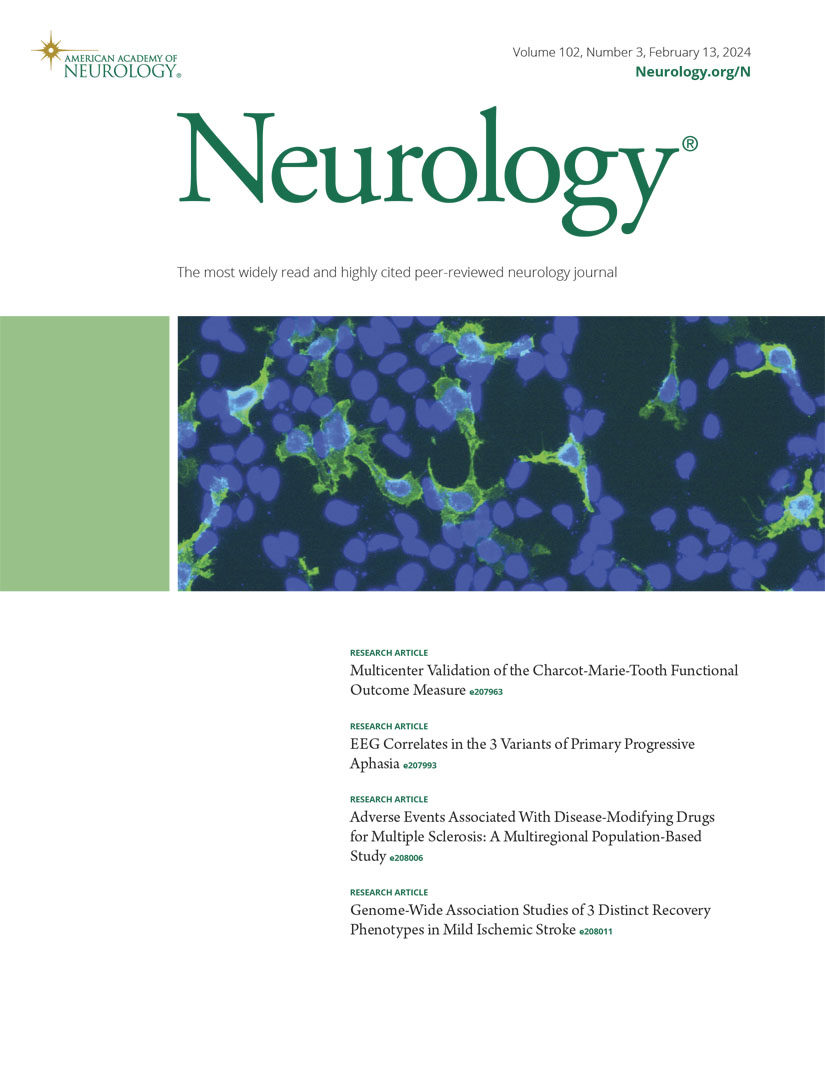Lifetime Risk of First Symptomatic ICH or Seizure in Familial Cerebral Cavernous Malformations: A Multicenter Patient Data Analysis.
IF 7.7
1区 医学
Q1 CLINICAL NEUROLOGY
引用次数: 0
Abstract
BACKGROUND AND OBJECTIVES Familial cavernous malformations (FCMs) are vascular lesions that pose a lifelong risk of symptomatic hemorrhage (SH) and seizures, yet their natural history remains unclear. This study aims to determine the cumulative lifetime risk of a first SH and/or seizure and assess whether genetic variations influence these risks. METHODS This international, multicenter retrospective cohort study included data from 16 tertiary referral centers and 1 patient advocacy group. Eligible patients had confirmed or suspected FCM, available magnetic resonance imaging (MRI) data, documented baseline clinical features, and longitudinal follow-up (FU). Functional outcomes were assessed using the modified Rankin Scale (mRS) at last FU. Direct adjusted survival curves and mixed-effects Cox regression analyses were performed to estimate cumulative lifetime risk. The association between genetic variations and SH/seizure rates was evaluated, and mixed-effects logistic regression assessed the effect of SH/seizures on mRS outcomes. RESULTS A total of 1,592 patients with FCM were included, with a mean age of 37.6 years (SD 17.1) and 55.7% female. The median FU was 42 years (IQR: 27-55), totaling 64,146 person-years. Of these, 869 (54.6%) had confirmed FCM, 775 (48.7%) experienced at least 1 hemorrhage, and 447 (28.1%) had at least 1 seizure. Genetic testing was performed in 47.7%, identifying CCM1 (31.0%), CCM2 (4.8%), and CCM3 (1.9%) variations. The lifetime risk of a first SH was ∼80%, with an event rate that remained constant beyond age 20. The lifetime risk of a first seizure was ∼45%. Patients with CCM3 variations exhibited a more aggressive hemorrhagic course than those with CCM1 (hazard ratio 1.799, 95% CI 1.008-3.208). SH and seizures were independently associated with worse mRS outcomes at last FU. DISCUSSION The event rate of SH and seizures remained stable over time, leading to high cumulative lifetime risks. Patients with CCM3 variations exhibited a more aggressive disease course. Limitations include the non-population-based design, selection bias from tertiary centers, retrospective data collection, and variability in data extraction across centers. However, this study represents the largest international FCM cohort to date, improving the precision of risk estimates and providing valuable insights into disease progression.家族性脑海绵状血管瘤患者首次症状性脑出血或癫痫发作的终生风险:一项多中心患者数据分析。
背景和目的家族性海绵状血管瘤(fcm)是一种血管性病变,可导致终生的症状性出血(SH)和癫痫发作,但其自然史尚不清楚。本研究旨在确定首次SH和/或癫痫发作的累积终生风险,并评估遗传变异是否影响这些风险。方法:这项国际、多中心回顾性队列研究纳入了来自16个三级转诊中心和1个患者倡导组织的数据。符合条件的患者有确诊或疑似FCM、可用的磁共振成像(MRI)数据、记录的基线临床特征和纵向随访(FU)。最后采用改良Rankin量表(mRS)评估功能结局。使用直接调整生存曲线和混合效应Cox回归分析来估计累积终生风险。研究人员评估了遗传变异与SH/癫痫发作率之间的关系,并用混合效应logistic回归评估了SH/癫痫发作对mRS结果的影响。结果共纳入FCM患者1592例,平均年龄37.6岁(SD 17.1),女性55.7%。中位FU为42年(IQR: 27-55),总计64146人年。其中,869例(54.6%)确诊为FCM, 775例(48.7%)至少经历过一次出血,447例(28.1%)至少发生过一次癫痫发作。47.7%的人进行了基因检测,确定了CCM1(31.0%)、CCM2(4.8%)和CCM3(1.9%)变异。首次SH的终生风险约为80%,20岁以后的发生率保持不变。首次癫痫发作的终生风险约为45%。CCM3变异患者的出血过程比CCM1变异患者更具侵袭性(风险比1.799,95% CI 1.008-3.208)。SH和癫痫发作与最后FU时较差的mRS结果独立相关。随着时间的推移,SH和癫痫发作的发生率保持稳定,导致较高的累积终身风险。CCM3变异患者表现出更具侵袭性的病程。局限性包括非基于人群的设计、三级中心的选择偏倚、回顾性数据收集以及各中心数据提取的可变性。然而,这项研究代表了迄今为止最大的国际FCM队列,提高了风险估计的准确性,并为疾病进展提供了有价值的见解。
本文章由计算机程序翻译,如有差异,请以英文原文为准。
求助全文
约1分钟内获得全文
求助全文
来源期刊

Neurology
医学-临床神经学
CiteScore
12.20
自引率
4.00%
发文量
1973
审稿时长
2-3 weeks
期刊介绍:
Neurology, the official journal of the American Academy of Neurology, aspires to be the premier peer-reviewed journal for clinical neurology research. Its mission is to publish exceptional peer-reviewed original research articles, editorials, and reviews to improve patient care, education, clinical research, and professionalism in neurology.
As the leading clinical neurology journal worldwide, Neurology targets physicians specializing in nervous system diseases and conditions. It aims to advance the field by presenting new basic and clinical research that influences neurological practice. The journal is a leading source of cutting-edge, peer-reviewed information for the neurology community worldwide. Editorial content includes Research, Clinical/Scientific Notes, Views, Historical Neurology, NeuroImages, Humanities, Letters, and position papers from the American Academy of Neurology. The online version is considered the definitive version, encompassing all available content.
Neurology is indexed in prestigious databases such as MEDLINE/PubMed, Embase, Scopus, Biological Abstracts®, PsycINFO®, Current Contents®, Web of Science®, CrossRef, and Google Scholar.
 求助内容:
求助内容: 应助结果提醒方式:
应助结果提醒方式:


